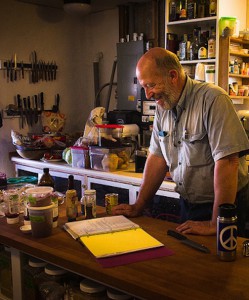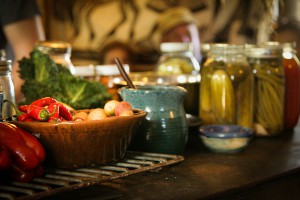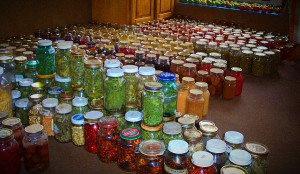
In this third installment in her series on Ecological Cooking, Dancing Rabbit member Sam talks about food co-ops, Dancing Rabbit Ecovillage-style!
It’s been a few weeks since we had an installment of our series on more sustainable cooking. That’s my bad; I’ve been out of town, and this particular topic is one that’s a little less straightforward than the ones I’ve covered so far. Nevertheless, without further ado, let’s learn a little bit about the ecological benefits of… Food Co-ops.
So far, with hayboxes and solar ovens we’ve talked about technologies that make smart use of facts of physics to use heat more efficiently. The food co-op is a technology that helps optimize not just the efficiency of heat, but also some more subtle impacts of feeding ourselves.
You might be familiar with one kind of co-op, one that’s almost exactly like a grocery store, with maybe a membership fee and an accompanying discount. At DR our food sharing manifests in different ways, often with a deeper involvement than store-type co-ops. Often there are chore rotations, shared kitchens, cook rotations, and meetings to decide what kind of leftover storage containers to use or whether teabag strings should go in the compost.
One term we hear a lot when talking about ways to improve our efficiency is “embodied energy” or “embodied impact.” That’s referring to the energy or impact that is used or incurred in order to get an object to us for use. A solar panel, or example, has a certain embodied impact from the energy used in manufacture, energy used to transport it, the energy and other impacts of mining for materials, and the infrastructure for the factories, transport vehicles, etc. Everything has an embodied impact “cost”.
One of the ways we can minimize our personal share of the impacts due to our kitchen appliances is to share them. When we share the object, we share the cost. If ten people are sharing one stove, fridge, sink, teakettle, etc, that divides each of our share of that impact by ten. Those of us living in intentional communities and large families have an advantage over those of us who live in single family homes. Many folk at Dancing Rabbit live in “cabins” within easy walking distance of each other and that don’t all have amenities like running water, a stove, a fridge, or even a table and chairs.

Here, also, we know each other well enough and share enough of a commitment to good communication and peaceful sharing of things, space, and chores, that having one kitchen every several households is a pretty natural decision. I know not everyone lives in an ecovillage, so sharing appliances with your neighbors might take more of an effort than it does for us. Honestly, that kind of thing is what makes places like Dancing Rabbit so special. That said, I have some ideas to help you get some of the benefits of food co-ops without tearing out your kitchen.Even without spreading the impact of our appliances over more than one household, there is efficiency to be gained by cooking larger batches, and sharing among more people. For one thing, cooking a large pot of stew, baking an oven full of baked goods, or sauteing large amounts of onions and garlic is more fuel efficient than doing the same amount of cooking spread over several kitchens.
That’s because each burner has its own heat loss and other inefficiency, and using more of them compounds more of that wasted energy. Having a dinner club to share meals with once a month, week, or day, can save a lot of fuel, even if everyone has their own kitchen. Of course, if everyone is traveling by car to get to the dinner club, you lose some or all of that advantage, but at least you get to hang out with your friends.
Eating in a big group might not appeal to everyone, and for those who prefer to dine alone or in smaller units, I have a solution as well. Try cooking very large batches of stews, pie filling, sauces, and other food that can be canned in family-meal size servings, canning them while they’re hot (which does add to the fuel used) and then either storing them for your own use or trading among friends. You get all the convenience of packaged food without the disposable waste. It doesn’t get you quite the efficiency that group meals will get you, but it does have some ecological advantages, allowing you to buy unprocessed food in bulk, cook in big batches, and buy produce (i.e., impactful-to-ship food) in season only.

If you can find a bulk natural food buying club in your area, you might be able to save money and packaging by buying your staple foods in large amounts and having them brought straight to your neighborhood, instead of to a store first. Check out www.UNFI.com to ask about buying clubs in your area. While I’m plugging unaffiliated websites, let me say that my favorite way to store, say, 25 pounds of rice, is in a reclaimed 5-gallon bucket with a Gamma Seal Lid on top. My favorite supplier of those lids is www.freckleface.com. Buy in quantity (with your neighbors and buying club members) and save!
Sharing cooking chores has an advantage outside the fuel savings as well: time savings. It might seem like a bit of a stretch to call it a more ecologically sustainable choice to spend less time cooking dinner, but consider what you, good citizen, might do with that extra time. Might you build a compost bin? Walk or bike instead of driving somewhere? Plant a garden? Write for a sustainability blog? Or maybe you’d spend more time cuddling your children, lifting weights, knitting, or getting a little more sleep. That’s cool, too.
Another advantage to food coops of all kinds is the efficiency of space they yield. Houses without kitchens, or high person-to-kitchen ratios are smaller, per person, than houses with kitchens, and that smallness leaves more room for wildlife, carbon sequestration, growing food, or some combination of those or other worthy uses of space. Plus, smaller spaces are easier to heat in the winter, saving fuel that way, too.
Food co-ops like those we have at Dancing Rabbit, with shared kitchens, rotating cook shifts, and shared gardens and garden chores, enable us to cut our use of energy, time, space, and the embodied impact of appliances. If more people in the world could find ways to share kitchens, the savings would add up. Since you probably live in a house with a kitchen already, perhaps getting to know your walkable neighbors well enough to share a meal occasionally, or making large batches and gifting them around the neighborhood, could make a positive difference both socially and ecologically.
• • •

Sam’s had experience as a scientist, a sailor, a dive guide, a bartender, a housewife, a teacher, a farmer, a vagabond, and a business owner before coming to live at Dancing Rabbit from 2009 to 2014 with her son. Now Sam spends her time working online, homeschooling, watching Netflix, reading, writing, and running a couple of tiny businesses.
